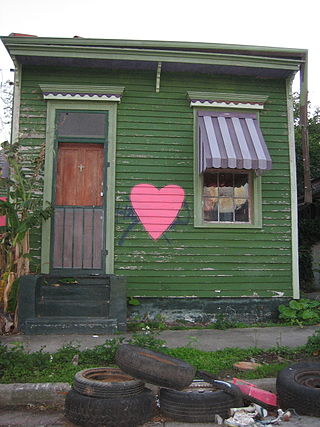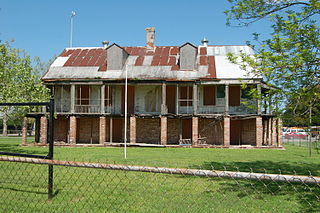
The Faubourg Marigny is a neighborhood of the city of New Orleans, Louisiana, United States.

The Central Business District (CBD) is a neighborhood of the city of New Orleans, Louisiana, United States.

Bywater is a neighborhood of the city of New Orleans. A subdistrict of the Bywater District Area, its boundaries as defined by the City Planning Commission are: Florida Avenue to the north, the Industrial Canal to the east, the Mississippi River to the south, and the railroad tracks along Homer Plessy Way to the west. Bywater is part of the Ninth Ward of New Orleans. It includes part or all of Bywater Historic District, which is listed on the National Register of Historic Places.

Cabbagetown is an intown neighborhood on the east side of Atlanta, Georgia, United States, abutting historic Oakland Cemetery. It includes the Cabbagetown District, a historic district listed on the U.S. National Register of Historic Places.

The Pillsbury A-Mill is a former flour mill located on the east bank of the Mississippi River in Minneapolis, Minnesota. It was the world's largest flour mill for 40 years. Completed in 1881, it was owned by the Pillsbury Company and operated two of the most powerful direct-drive waterwheels ever built, each capable of generating 1,200 horsepower . In 1901 one of the turbines was replaced with a 2,500 horsepower one. Both the mill and its headrace tunnel are contributing resources to the St. Anthony Falls Historic District, which is on the National Register of Historic Places. The mill is also independently on the NRHP. The mill was named a National Historic Landmark in 1966 and has since been converted into the A-Mill Artist Lofts.

A shotgun house is a narrow rectangular domestic residence, usually no more than about 12 feet (3.5 m) wide, with rooms arranged one behind the other and doors at each end of the house. It was the most popular style of house in the Southern United States from the end of the American Civil War (1861–65) through the 1920s. Alternative names include shotgun shack, shotgun hut, shotgun cottage, and in the case of a multihome dwelling, shotgun apartment; the design is similar to that of railroad apartments.

The New Orleans Botanical Garden is a botanical garden located in City Park, New Orleans, Louisiana. The first classical garden in New Orleans, it was funded by the Works Progress Administration.

The architecture of Houston includes a wide variety of award-winning and historic examples located in various areas of the city of Houston, Texas. From early in its history to current times, the city inspired innovative and challenging building design and construction, as it quickly grew into an internationally recognized commercial and industrial hub of Texas and the United States.

The Roosevelt New Orleans in New Orleans, Louisiana, is a 504-room hotel owned by AVR Realty Company and Dimension Development and managed by Waldorf Astoria Hotels & Resorts. The hotel was originally built by Louis Grunewald, a German immigrant, and opened in 1893 as "The Hotel Grunewald."

The New Orleans Museum of Art is the oldest fine arts museum in the city of New Orleans. It is situated within City Park, a short distance from the intersection of Carrollton Avenue and Esplanade Avenue, and near the terminus of the "Canal Street - City Park" streetcar line. It was established in 1911 as the Delgado Museum of Art.

Fulton Bag and Cotton Mills is a formerly operating mill complex located in the Cabbagetown neighborhood of Atlanta, Georgia. Construction of the complex began in 1881 on the south side of the Georgia Railroad line, east of Downtown Atlanta, on the site of the Atlanta Rolling Mill. The site now includes separate phases of multi-family dwellings including for-rent apartments and for-sale condominiums.

The buildings and architecture of New Orleans reflect its history and multicultural heritage, from Creole cottages to historic mansions on St. Charles Avenue, from the balconies of the French Quarter to an Egyptian Revival U.S. Customs building and a rare example of a Moorish revival church.

St. Roch is a neighborhood of the U.S. city of New Orleans. A subdistrict of the Bywater District Area, its boundaries as defined by the City Planning Commission are: Lafreniere Street, Paris Avenue, I-610, Benefit Street, and Dahlia Walk to the north; People's and Almonaster Avenues to the east; St. Claude Avenue to the south; Elysian Fields Avenue, Hope, Frenchmen, Duels, St. Anthony, Industry, Allen, & Agriculture Streets, A.P. Tureaud Avenue, Abundance, Republic, Treasure, & Dugue Streets, and Florida & St. Bernard Avenues to the west.

Immaculate Conception church, locally known as Jesuit church, is a Roman Catholic church in the Central Business District of New Orleans, Louisiana. The church is located at 130 Baronne Street, and is part of the local Jesuit community. The present church, completed in 1930, is a near duplicate of an earlier 1850s church on the same site.

The Dry Dock Complex consists of six interconnected buildings located at 1801–1803 Atwater Street in Detroit, Michigan, as well as the remains of a nearby dry dock at 1900 Atwater Street. The 1801-1803 Atwater complex is also known as the Globe Trading Company Building, and in 2015 was opened by the Michigan Department of Natural Resources as the Outdoor Adventure Center.

International House is a boutique hotel in New Orleans’ central business district, located two blocks from the French Quarter, at 221 Camp Street. Described by Frommer's as “a modern space that still pays tribute to its locale,” its design mixes contemporary and traditional elements reflective of New Orleans’ unusual culture. It is known for historic Beaux-Arts architecture and its Loa Bar, which serves signature cocktails prepared by bartender Alan Walter. International House has been called New Orleans’ first boutique hotel.

Loft 523 is a boutique hotel located at 523 Gravier Street in New Orleans, Louisiana, in the New Orleans Central Business District. The building was erected in the 1880s as a carriage and dry-goods warehouse, and it was purchased and renovated by real-estate developer Sean Cummings. It features eighteen loft style guestrooms, three of which are penthouses.
Entrepreneurs’ Row is a New Orleans loft-style office building owned by International House Hotel and created by entrepreneur Sean Cummings in July 2007. Located at 220 Camp Street, it houses several of the city's fledgling startups.

Bienville House, or the Bienville House Hotel, is a hotel in the French Quarter of New Orleans, Louisiana. Its building dates from 1835. It was converted to a hotel in 1967.

Godchaux–Reserve Plantation, also known as Godchaux–Boudousquie Plantation, and the Reserve Plantation, is a former plantation, former site of a sugar refinery, and once included a historic house built in 1764, located in Reserve, St. John the Baptist Parish, Louisiana.



















